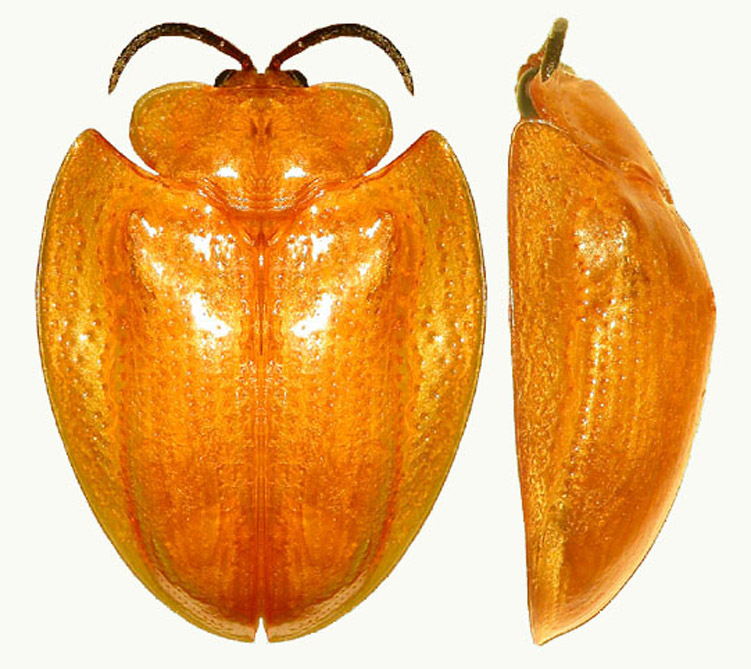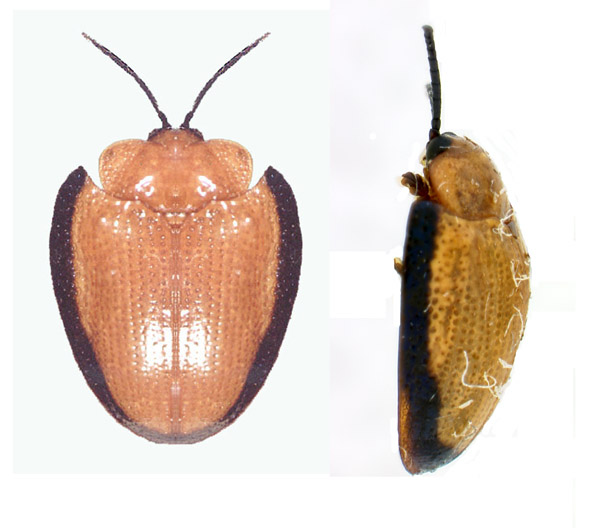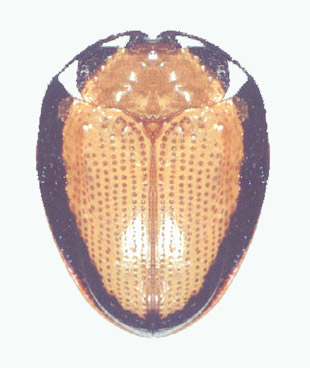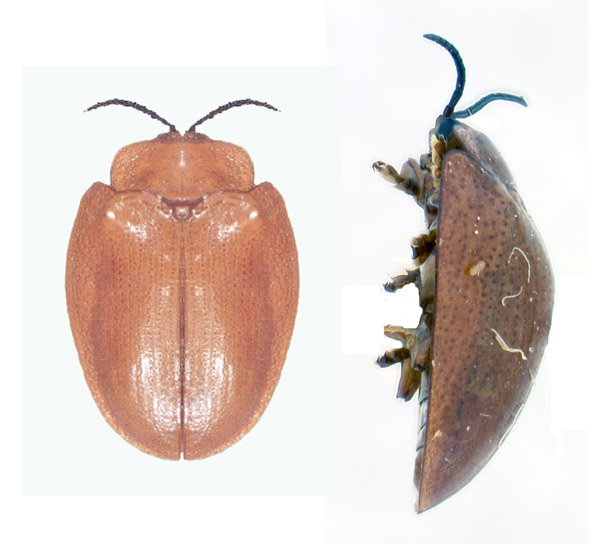Calyptocephala
|
Calyptocephala paralutea |
|
Calyptocephala marginipennis |
|
Calyptocephala gerstaeckeri |
|
Calyptocephala brevicornis |
Introduction
Calyptocephala Chevrolat (Coleoptera: Chrysomelidae: Cassidinae) contains 12 species from South America (Staines 2012) and is in need of revision. Four species have been reported feeding on palms.
Distribution
Calyptocephala brevicornis Boheman is found in Argentina (Misiones), Brazil (Amapá, Amazonas, Goiás, Matto Grosso, Minas Gerais, Parná, Rio Grande do Sul, São Paulo), Colombia, Guatemala, México, Nicaragua, Panamá, Paraguay, and Venezuela.
Calyptocephala gerstaeckeri Boheman is found from Belize, Costa Rica, Guatemala, México, Nicaragua, and Panamá.
Calyptocephala marginipennis Boheman is found in French Guyana, Guatemala, México, Nicaragua, and Venezuela.
Calyptocephala paralutea Buzzi & Miyazaki is found in Brazil (Amapá).
Hosts
Calyptocephala brevicornis feeds on Arecastrum romanzoffiana (Cham.) Becc. (Monrós & Viana 1951); Elaeis guineensis Jacq. (Moura 1985); Chamaedorea tepejilote Liebm. (Windsor et al. 1992); C. wendlandiana Hemsl. (Meskins et al. 2008) (Arecaceae); Dioscorea sp. (Dioscoreaceae), and Chusquea sp. (Poaceae) (Windsor et al. 1992).
Calyptocephala gerstaeckeri feeds on Elaeis guineensis Jacq., Chamaedorea elegans Mart. (Córdova-Ballona & Sánchez-Soto 2008); and Ch. tepejilote Liebm. (Naczi & Staines 2011) (Arecaceae).
Calyptocephala marginipennis feeds on Chamaedorea tepejilote Liebm. (Oyama & Mendoza 1990) and Bactris gasipaes Kunth. (Mora-Urpí et al. 1997) (Arecaceae).
Calyptocephala paralutea feeds on Elaeis guineenis Jacq. (Moura 1985) and Astrocaryum sp. (Buzzi & Miyazaki 1992) (Arecaceae).
Damage
Feeding damage from Calyptocephala species results from the destruction of the parenchyma. Both adults and larvae feed on the surface of palm fronds making feeding channels a few centimeters in length parallel to the midrib. Damage is greater during the rainy season because fungi invade the feeding areas.
Life history notes
Moura (1985) studied the biology of C. brevicornis on E. guineensis in Brazil. Eggs are flat, gelatinous, cream-colored, and placed on the undersides of fronds. The larvae are whitish just after hatching and turn brownish in 18 hours. Adults average 6.7 mm in length and males are smaller than females.
Córdova-Ballona & Sánchez-Soto (2008) studied the biology of C. gerstaeckeri in México. The oval, flattened eggs are laid individually on the surface of palm fronds. They are translucent when newly laid and become creamy-colored as they mature. The larva has creamy-white head with the prothoracic shield, distal part of the legs, and apex of abdomen light coffee-colored. They undergo six instars.
Oyama (1997) published a few biological notes on C. marginipennis in México. Adults remain on individual host plants for long periods of time and move from plant to plant and between plots fairly regularly. Sánchez-Soto & Ortiz-García (1998) reported this species from both young and mature palms.
Bibliography
Buzzi, Z. J. & R. D. Miyazaki. 1992. Calyptocephala paralutea sp. n. e descrição da larva e pupa (Coleoptera, Chrysomelidae, Cassidinae). Revista Brasileira de Zoologia 9 (1/2): 157-166.
Córdova-Ballona, L. & S. Sánchez-Soto. 2008. Datos bionómicos y descripción de los immaduros de Calyptocephala gerstaeckeri Boheman (Coleoptera: Chrysomelidae), plaga de la Palma Aceitera (Elaeis guineensis J.) y de la Palma Camedor (Chamaedorea elegans Mart.) (Arecaceae) en Tabasco, México. Neotropical Entomology 37 (6): 674-680.
Meskins, C., D. Windsor, & T. Hance. 2008. A comparison of hispine beetles (Coleoptera: Chrysomelidae) associated with three orders of monocot host plants in lowland Panama. International Journal of Tropical Insect Science 27 (3/4): 159-171.
Monrós, F. & M. J. Viana. 1951. Las Cassidinae de la seccion “Hemisphaerotina” con revision de las especies Argentinas (Col. Cassidinae). Acta Zoologica Lilloana 11: 367-395.
Mora-Urpí, J., J. C. Weber, & C. R. Clement. 1997. Peach palm, Bactris gasipaes Kunth. Promoting the conservation and use of underutilized and neglected crops. 20. International Plant Genetic Resources Institute. Gatersleben, Germany. 82 pp.
Moura, J. I. L. 1985. Incidência de Calyptocephala brevicornis (Boheman, 1850) (Coleoptera: Chrysomelidae, Cassidinae) en cultura de dendê (Elaeis guineensis) no Município de Porto Platon, Território Federal do Amapá. Anais da Sociedade Entomológica do Brasil 14 (1): 37-43.
Naczi, R. F. C. & C. L. Staines. 2011. Noteworthy records of hispines from Belize (Coleoptera: Chrysomelidae). Insecta Mundi 0190: 1-6.
Oyama, K. 1997. Calyptocephala marginipennis. p. 319 in E. G. Soriano, R. Dirzo, & R. C. Vogt (eds.). Historia natural de Los Tuxtlas. Universidad Nacional Autónoma de México.
Oyama, K. & A. Mendoza. 1990. Effects of defoliation on growth, reproduction, and survival of a Neotropical dioecious palm, Chamaedorea tepejilote. Biotropica 22 (2): 119-123.
Sánchez-Soto, S. & C. F. Ortiz-García. 1998. Oil palm pests and pollinators in Tabasco, Mexico. ASD Oil Palm Papers 18: 25-28.
Staines, C. L. 2012. Tribe Spilophorini. Catalog of the hispines of the world (Coleoptera: Chrysomelidae: Cassidinae). http://entomology.si.edu/Collections_Coleoptera.html
Windsor, D.M., E.G. Riley, H.P. Stockwell. 1992. An introduction to the biology and systematics of Panamanian Tortoise Beetles (Coleoptera: Chrysomelidae: Cassidinae). pp. 372-391. In: D. Quintero, A. Aiello, Insects of Panama and Mesoamerica, Selected studies. Oxford Univ. Press, Oxford.






